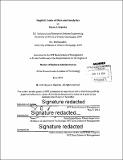Implicit costs of data and analytics
Author(s)
Kapicka, Bryan A. (Bryan Anderson)
DownloadFull printable version (2.601Mb)
Other Contributors
Sloan School of Management.
Advisor
Erik Brynjolfsson.
Terms of use
Metadata
Show full item recordAbstract
Firms have been able to utilize data and analytics to achieve a variety of economic benefits. To realize this value, firms have to invest in the necessary information technology, process updates, and employee training. These costs are straightforward, but firms also incur implicit costs, the costs of mitigating potential risks and maximizing firm value from data and analytics. These costs are less well understood. This paper focuses on two of these costs, the mitigation of the adverse effects of metrics and the investment required to effectively complement people with information technology. The first cost is the adverse effects of metrics and refers to the potential for metrics and analytics to compromise business objectives that they were originally intended to enhance. The analysis of this cost primarily utilizes Holmstrom and Milgrom's Multitask Principal-Agent Model to evaluate the impacts that incentives, metrics, measurability, and job design have on the firm's payoff. This model and ensuing analysis provide guidance for firms to avoid the pitfalls that accompany an increased reliance on data and analytics. The second cost refers to the firm's investment to complement people with information technology to maximize their payoff from data and analytics. The evaluation of this cost discusses the conditions under which it is appropriate to complement, or substitute, humans with technology. In the scenarios where people are complemented by technology, this paper outlines additional practices and examples to highlight ways in which a complementary relationship between people and information technology can be cultivated. This discussion covers the efforts to shift people away from solely relying on intuition, while preventing them from blindly accepting data and empowering them to deal with the inherent complexity of new information afforded by data and analytics. The analysis and discussion of each cost references existing research and case examples. This paper intends to further the understanding of these costs as well as identify future opportunities for research.
Description
Thesis: M.B.A., Massachusetts Institute of Technology, Sloan School of Management, 2014. Cataloged from PDF version of thesis. Includes bibliographical references (pages 69-72).
Date issued
2014Department
Sloan School of ManagementPublisher
Massachusetts Institute of Technology
Keywords
Sloan School of Management.